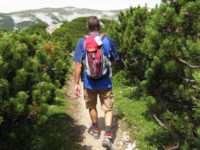Guest post by Travis Holloway
Hiking is a superb way to boost spirits and declutter your mind when things around you get overwhelming and you want a break. However, being also a physically demanding activity, hiking can sometimes backfire on the tourists who are poorly prepared to deal with its inherent challenges.
Taking basic safety measures such as wearing protective knee sleeves will make sure you do not suffer unnecessary discomfort and traumas. However, a hiking knee brace is not the only option to keep your kneecaps safe when you hit the trail. Below there is a description of some other helpful things you can try.
How to Care for Your Knee Joints on a Hike?
There is no shame in wanting to use knee protection during a long-distance hiking trip. A nasty injury needs a second to happen and can take months to heal, so prevention is key. Here are the top-5 ways to utilize hiking gear to spare your knees excessive stress while exploring the wilds:
1. Use trekking poles
To enhance your stability on the trail and keep your joints, such as knees and ankles, out of danger, consider using trekking poles. This kind of hiking gear helps improve your overall posture, distribute weight correctly, and add balance on uneven or slippery terrains. Trekking poles can also increase the average hiking speed by introducing a consistent and well-paced rhythm to your movements.
While it is best to get a pair of professionally designed trekking poles whose characteristics fully meet your unique physical requirements, such equipment can sometimes cost you a pretty penny. If you feel up to it, you can try creating walking sticks yourself using a suitable and sturdy piece of wood and a sharp knife.
2. Buy proper footwear
Selecting a pair of boots that are fit for the occasion is the number one rule of any safe outdoor activity. Correct hiking footwear will make you feel comfortable and unrestricted, enhance your steadiness on slippery trails, reduce pressure on your knees, hips, and lower back. While adding specialized insoles will give you extra comfort and support. Also, check Merino wool socks from Blundstone to keep your feet snug and comfortable.
When shopping for hiking boots, go for the ones that are breathable, waterproof, and made of sturdy, durable materials. Make sure your footwear has a good traction and offers enough flexibility to allow your feet a wide range of motion. Ideally, it should be a pair that fits snug everywhere, does not feel tight or restrictive in any particular place, and provides your toes with enough room to wiggle around.
3. Grab a pair of compression socks
One of the easiest and surest ways to give your muscles and joints the needed stability on a hiking trail is to use compression socks. Apart from providing added support in all the right places, well-chosen hiking compression socks will facilitate faster muscle recovery, reduce blisters and swelling, and improve blood flow to the area.
However, one needs to be careful when picking compression socks as not to fall victim to misleading marketing gimmicks. Poorly made hiking compression socks that feel too tight will make your lower extremities suffer from the inadequate blood supply and cause a lactic acid buildup, leading to cramps, sore muscles, and muscular fatigue.
Additionally, some of the top joint pain supplements are formulated to reduce inflammation, improve mobility, and support cartilage health, providing relief for those with arthritis or general joint discomfort.
4. Invest in supporting knee braces
Designed specifically to keep your knees safe and healthy, hiking knee braces are a smart investment. They reliably protect the parts that are the most vulnerable to hiking injuries, such as kneecaps and tendons, offering ample compression and comfortable support. If a trauma does occur, this piece of hiking gear should be able to provide substantial pain relief by reducing swelling and inflammation.
The choice of supportive braces for your knees is wide. They can be long or short, slim and lightweight or more restrictive, have a close-end or open design. Which type will work best for you depends on your individual needs and the kind of outdoor activity you are planning to engage in.
5. Consume enough Omega-3 fatty acids
Your knees will remain well lubricated, resisting injuries better and recovering from those faster if you consume enough Omega-3 fatty acids with your food or as a separate fish oil dietary supplement. A hiker’s daily diet should include eatables like egg yolks, walnuts, olive oil, flaxseed, and chia seeds.
What else to keep in mind?
Your knees can feel tight and tense after a long hike, even if you follow all of the above tips. Adopt the habit of doing a series of muscle-stretching exercises and consider learning basic self-massage techniques to relieve soreness in your feet and calf muscles.
What is your preferred way to protect your knees on a hike? Do you have any helpful advice to share or want to ask us a question? Feel free to speak up in the comments section below!





